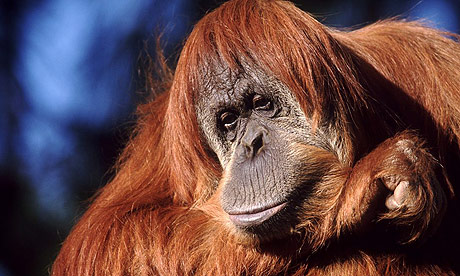
An orang-utan in Sumatra, Indonesia. Photograph: Michael DeYoung/Corbis
Sri Lanka's Horton Plains slender loris has been seen just four times since 1937. Miss Waldron's red colobus monkey was not found in an exhaustive six-year study ending in 1999 and there have been no definite sightings since. Vietnam's golden-headed langur and the Hainan gibbon in China both number in the dozens.
These are the primate species on the edge of oblivion and, according to a report commissioned by three leading conservation charities, scores of others of our closest relatives are poised to suffer the same fate. It names the top 25 species most in need of help but concludes that 114 primate species are also close to extinction.
The 25 species most at risk include two of our closest great ape cousins, the Cross River gorilla of Cameroon and Nigeria and the orang-utan from Sumatra. Miss Waldron's colobus also makes it on to the list, although more by hope than expectation. Conservationists declared it officially extinct in 2000, but a photograph taken since then of a similar-looking creature has been tentatively identified by scientists.
The document was compiled by 60 leading primatologists from the world conservation union, the International Primatological Society and Conservation International. The list includes 11 species from Asia, seven from Africa, four from Madagascar and three from South America.
"You could fit all the surviving members of these 25 species in a single football stadium; that's how few of them remain on Earth today," said Russell Mittermeier, the president of Conservation International.
"The situation is worst in Asia, where tropical forest destruction and the hunting and trading of monkeys puts many species at terrible risk. Even newly discovered species are severely threatened from loss of habitat and could soon disappear."
The report follows assessments in 2000, 2002 and 2004. "Overall the problems are increasing," said Eckhard Heymann at the German Primate Centre in Goettingen, one of the report's authors. Common problems are habitat loss due to logging for timber or oil and mineral extraction, plus bushmeat hunting. The two issues are related because roads cut through tropical forests for logging trucks help give hunters easier routes to wildlife. "Every additional access to remove areas increases the access to hunters," Dr Heymann added.
Another problem is habitat destruction to make space for biofuel plantations such as oil palm. Developed economies such as the US and Europe are pledging to use more sustainable energy sources to combat climate change, but this is having a knock-on effect on tropical wildlife. "It is creating a huge market and now in several countries politicians are thinking of converting tropical forest areas to palm plantations," he said.
This particularly affects orang-utan populations. Although they still number in the low thousands, they are disappearing as a faster rate than any other primate species.
Dr Heymann said there had been some successes since the previous report. The golden lion tamarin from eastern Brazil, for example, had benefited from a concerted conservation campaign which involved protecting fragments of forest where it lives and breeding it in captivity. "There are still not much more than 1,000 but they are stable and no longer declining," said Dr Heymann. "The species is not yet safe but still it's a success story."
Most endangered
MadagascarGreater bamboo lemur (Prolemur simus); White-collared lemur (Eulemur albocollaris); Sahamalaza Peninsula sportive lemur (Lepilemur sahamalazensis); Silky sifaka (Propithecus candidus)
Nigeria, CameroonCross River gorilla (Gorilla gorilla diehli)
Ivory Coast, GhanaMiss Waldron's red colobus (Procolobus badius); Roloway monkey (Cercopithecus diana roloway)
TanzaniaRondo dwarf galago (Galagoides rondoensis); Kipunji (Rungwecebus kipunji)
KenyaTana River red colobus (Procolobus rufomitratus)
Equatorial GuineaPennant's red colobus (Procolobus pennantii pennantii) (Island of Bioko)
Colombia, VenezuelaVariegated spider monkey (Ateles hybridus)
Colombia, EcuadorBrown-headed spider monkey (Ateles fusciceps)
Peru Peruvian yellow-tailed woolly monkey (Oreonax flavicauda)
Bangladesh, India, BurmaWestern Hoolock gibbon (Hoolock hoolock)
Sri LankaHorton Plains slender loris (Loris tardigradus nycticeboides); Western purple-faced langur (Semnopithecus vetulus nestor); Pig-tailed langur (Simias concolor)
Indonesia (Mentawai Islands)Indonesia Pig-tailed langur (Simias concolor) (Mentawai Islands); Sumatran orang-utan (Pongo abelii) (Sumatra); Siau Island tarsier (Tarsius sp.)
VietnamDelacour's langur (Trachypithecus delacouri); Golden-headed langur (Trachypithecus poliocephalus poliocephalus); Grey-shanked douc (Pygathrix cinerea); Tonkin snub-nosed monkey (Rhinopithecus avunculus)
ChinaHainan black-crested gibbon (Nomascus hainanus) (Hainan Island)






The Earth from Space(11 pictures)






Gallery: Wicker Elephants(10 pictures)


New species of leopard discovered(2 pictures)






